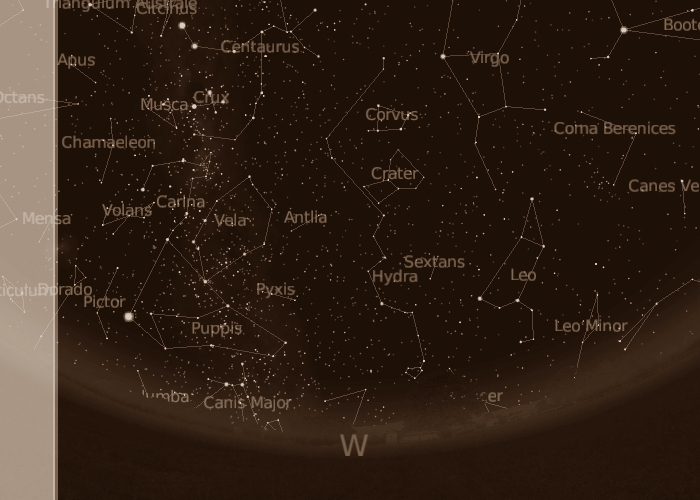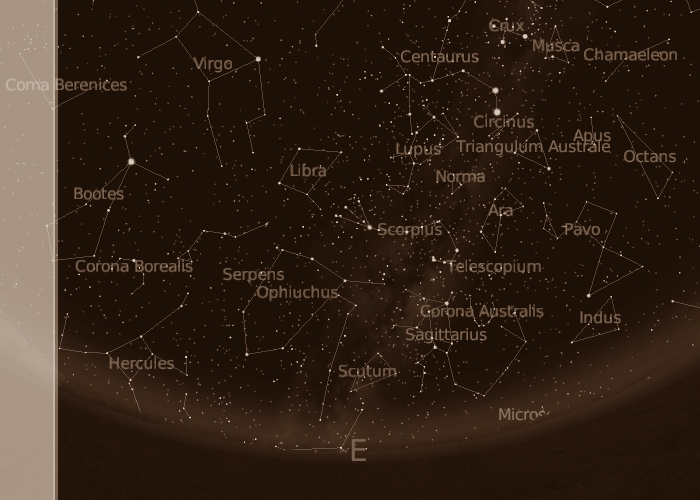Western Horizon
Eastern Horizon
![]()
Western Horizon
Eastern Horizon

We're deep in fall now! The southern sky, in fall, is displaying a major show. Namely, that large band of Milky Way-embedded, typically southern constellations, which is seen arching over the southern horizon, from Sagittarius, the Archer, to Sirius, southwest! Let's turn South! See how the show's great! Let's follow the band, from southeast to southwest! Sagittarius, first, the Archer. It's there that the center of our Milky Way Galaxy is lying, this large, yellow bulge of old stars at the center of which a supermassive black hole is lurking, of the size of the orbit of Mercury! As, with our Sun, we are inside the Galaxy, we can't get a view of it, as we just catch it under the form of the Milky Way. We are just seeing the Galaxy from inside! As, when we look to Orion, we're looking to the outer, blue arms of it, and when we look to Sagittarius, we're looking to the Galaxy's center. Just a great feeling! Scorpion, the Scorpion, a fine constellation, is now high. Lupus, the Wolf, is found further, and then Centaurus, the Centaur. The two bright stars there are the famed so-called 'Pointer' -Alpha Centauri and Agena that is- those stars which are 'pointing' to Crux, the Southern Cross! Crux, that small cross, is the constellation, which, in the southern hemisphere allows to locate the southern celestial pole. Further along the band of constellations, those are the the constellations which had been born, in the 18th century, from the division of the antique and vast Argo, the Ship, that constellation which was figuring the ship of the Argonauts, those Greek heroes who left in search of the Golden Fleece. From Crux to Canis Major, they are Carina, the Ship's Keel, Vela, the Ship's Sails, and Puppis, the Ship's Stern. Those much fine views are complemented with much others. The row below the band is filled with typically southern constellations which are not seen during the other parts of the year, as, there too, you'll be able to spot both the Magellanic Clouds. They were named such because it's the European explorer, Magellan, who likely first saw them, as he had embarked the first world round-trip. Two globular clusters, like Omega Centauri, or 47 Tucanae are observable too in that part of the sky! Back to West now! West, the long chain of Hydra is a fine show, as Sextans, the Sextant, Crater, the Cup and Corvus, the Crow, are anchored along. Leo, the Lion, may be another center of interest, with Leo's Sickle, Regulus, and Denebola. Deep-sky amateurs will note how the deep-sky galaxy fields of Virgo and Coma Berenices are high, hence prone to a good observation. They're about their best. to a printer-friendly chart
West for the tropics. West for the mid-northern latitudes

All the right part of the eastern sky is filled with the left part of the Milky Way-embedded constellations -and even with parts, southeast, of the typical southern ones! Libra, the Scales, is atop Scorpio. Such a constellation once figured the claws of the beast. Ophiuchus, below, is to be found, with its two serpents, as Hercules, the Heroe, is still low northeast. The bright star, high, northeast, is Arcturus, of Bootes, the Herdsman, as Corona Borealis, is a fine, small constellation. Those, with a completely plain northern horizon will be able to spot some stars of the Big Dipper, this distinctive feature of the skies in the northern hemisphere. Canes Venatici, the Hunting Dogs, are seen above them. Fine! to a printer-friendly chart
East for the tropics. East for the mid-northern latitudes
(color maps with Stellarium; printer-friendly charts with Cartes du Ciel, Patrick Chevalley)
Website Manager: G. Guichard, site 'Amateur Astronomy,' http://stars5.6te.net. Page Editor: G. Guichard. last edited: 12/28/2010. contact us at ggwebsites@outlook.com